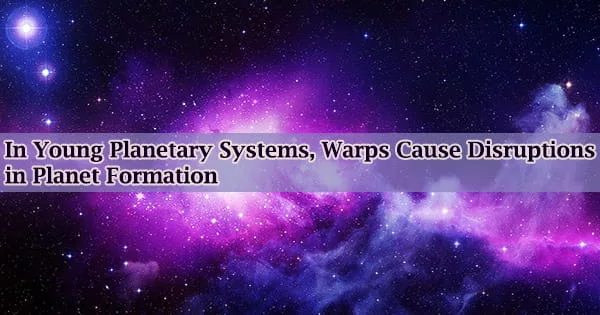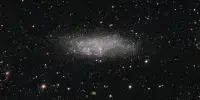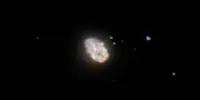Passing stars, misaligned double stars, and passing gas clouds all have an impact on the formation of planets in early star systems, according to a new study from the University of Warwick.
Scientists have created models that show how cosmic events such as these might bend protoplanetary discs, which are the birthplaces of planets, during the early formation of solar systems. In a study financed by The Royal Society and the Engineering and Physical Sciences Research Council, part of UK Research and Innovation, their findings were published today in the Astrophysical Journal.
Protoplanetary discs, vast spinning clouds of gas and dust that eventually coalesce into the variety of planets that we see in the Universe, are the building blocks of solar systems. When these discs are young, they create spiral structures, with all of their dust and material being drawn into dense arms by the disc’s immense gravitational effect.
However, astronomers have discovered a surprising number of protoplanetary discs that lack a spiral structure despite being massive enough to have one. The researchers at the University of Warwick have been looking at what prevents a disc from spiraling.
Since the introduction of General Relativity, cosmology has been a well-established scientific discipline. General Relativity portrays a dynamic Universe that isn’t static in most circumstances, as was swiftly realized.
Using a technique known as smoothed-particle hydrodynamics, PhD student Sahl Rowther of the University’s Department of Physics produced a three-dimensional hydrodynamical simulation of a normal, flat self-gravitating disc.
Once we started getting observations of warped discs, we had to start considering warps in our modelling. We need a greater consideration of warps in protoplanetary disc evolution and understanding that warps can impact existing disc evolution mechanisms and physics. We need to consider how warps affect all the factors in planetary formation.
Dr. Rebecca Nealon
He experimented with varying levels of curvature on the disc to see how it affected the spiral structure. The spiral structure vanished in all but the tiniest warps.
Cosmology also reflects our understanding of gravity, i.e. general relativity, as the most important determinant of how the universe evolves on the biggest scales. The spiral structure of a protoplanetary disc is critical for planet formation via Gravitational Instability, and the findings help us better understand how solar systems evolve.
Co-author Dr. Rebecca Nealon, Stephen Hawking Fellow in the Department of Physics, said:
“Warps will inhibit planet formation through Gravitational Instability, in the sense that these spiral structures, which fragment into clumps that eventually form planets, are where the disc structure will be disrupted. Anything that disturbs that spiral structure makes it harder for that clumping to occur and harder for the planets to form via Gravitational Instability.”
The warp heats up the disc by causing minor perturbations in the velocity of the gas as it revolves, according to the scientists. Because the gas must be chilled in order to clump together, the spiral arm structure is destroyed when the disc is heated.
A protoplanetary disc can be twisted in a variety of ways. A flyby encounter with a big object, such as a star; if the disc surrounds a binary star system that orbits out of alignment with the disc; or if a nearby source of gas accretes onto the disc are just a few scenarios.
Evidence of distorted protoplanetary discs has increased dramatically in recent years, implying that they are more frequent in the Universe than previously thought. It may also explain why a huge fraction of enormous protoplanetary discs lack a spiral shape.
Dr. Nealon adds: “Normally we think of these discs forming in isolation, but that’s not really the case. It’s a chaotic neighbourhood, with lots of stars nearby, and you might have a star that passes close by and that gravitational interaction is enough to cause this warp.”
“Once we started getting observations of warped discs, we had to start considering warps in our modelling. We need a greater consideration of warps in protoplanetary disc evolution and understanding that warps can impact existing disc evolution mechanisms and physics. We need to consider how warps affect all the factors in planetary formation.”
In practical terms, the major purpose is to eliminate prescientific views about how the world created unequivocally, allowing people to question what other prescientific notions are worth revisiting.
Sahl Rowther said: “This study combines two physical effects that haven’t been combined before, the physics of self-gravitating discs with the warp. This is important because self-gravitating discs have been studied for a while and it’s a well-established field. Warps are a much more recent idea.”
“We have modelled this in the most simple way possible to allow us to be really sure about what we’ve done, and to easily demonstrate it.”
















